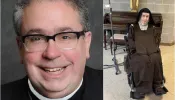By: Fr. Frank Pavone, National Director, Priests for Life
There hasn't been a legislative victory for foes of abortion like the partial-birth abortion ban in a long time. Maybe that's why the opponents of the ban don't seem to know how to adjust to reality. They exhibit all the signs of denial.
After years of expert testimony from hundreds of physicians, and the failure of anyone to identify a single medical complication that can be solved only by a partial-birth abortion, foes of the ban continue to insist that the procedure is necessary for the health of women.
After the will of the American people has been made evident by poll after poll, and by the fact that over half the states passed bans on this procedure, foes of the ban continue to behave as if the public wants partial-birth abortion.
And after two of the three co-equal branches of government -- the Legislative and the Executive -- have exercised their power in a bi-partisan way to stop partial-birth abortion, foes of the ban go running like offended children to unelected judges, asking them to contradict the will of the people and overrule the other two branches of government.
It's time for a reality check. No amount of slogans, rhetoric, or abstract reasoning can take away the horror of the partial-birth abortion procedure. Legislators who identify themselves as "pro-choice" and vote in other contexts to uphold abortion rights have, in large numbers, concluded that partial-birth abortion goes too far. That is due in large part to the fact that in this debate, for the first time, attention was focused on what actually happens to the baby during the abortion. While it is easy to talk about "rights, freedoms, and choices," it is hard to talk about methods of killing -- so hard, in fact, that some in the media have refused to describe how a partial-birth abortion takes place.
Opponents of the ban on partial-birth abortion are constructing for themselves a public relations nightmare if they continue fighting a battle they have lost. Whose support do they hope to gain for keeping this procedure legal? Or perhaps do they not care whether they have anyone's support, as long as they can deceive people with slogans, mask over the violence of this procedure, and subvert the ability of the American people to govern themselves rather than be governed by an oligarchy of federal judges?
One of the ironic elements to this dispute is that we seem to have finally found a piece of ground in the abortion war on which pro-life and pro-choice people, in large numbers, can agree and unite. But radical pro-abortion supporters don't want to accept that. Yet, as usual, it is the pro-life camp that is accused of being "divisive."
What, then, is the next step for America regarding partial-birth abortion?
First, if pro-choice radicals keep pushing for partial-birth abortion, they will fall victim to what feminist author Naomi Wolf warned about when she wrote, "[W]e stand in jeopardy of losing what can only be called our souls. Clinging to a rhetoric about abortion in which there is no life and no death, we entangle our beliefs in a series of self-delusions, fibs and evasions. And we risk becoming precisely what our critics charge us with being: callous, selfish and casually destructive men and women who share a cheapened view of human life" (Our Bodies, Our Souls, The New Republic, 1995).
Second, if the courts continue to flatly contradict the clear, strong and consistent will of the American people, we may finally awaken to the need to restore a balance of power in our government. No longer will special interest groups be able to short-circuit the legislative system in order to accomplish their goals.
Third, maybe the partial-birth abortion debate has taught us a new way of looking at abortion -- namely, to examine what the procedure actually does, rather than go round and round about "Who decides?" Reading medical descriptions and seeing diagrams of the other abortion procedures reveals them as horrifying as partial-birth abortion.
If all that happens, the pro-choice movement is in a lot of trouble.
Printed with permission from Priests for Life.











